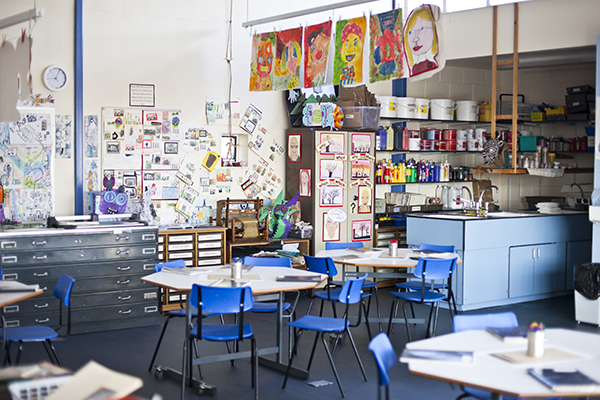After receiving more than 15,000 responses in its largest ever consultation, Ofsted’s updated inspection framework, published earlier this month, will come into effect this September. But what does it mean for arts education?
Arts education has taken a beating in recent years
In 2012, then Education Secretary Michael Gove proposed the rollout of the English Baccalaureate (EBacc), a qualification requiring GCSE pupils to take “core academic subjects”, with no mention of the arts.
Gove’s successor, Nicky Morgan, warned pupils that choosing arts subjects could “hold them back for the rest of their lives”. With those responsible for developing education policy seemingly quick to side-line arts education, the value of some subjects is called into question, while that of others is are taken for granted.
And the impact of a declining focus on arts education is all too evident. A 2017 report from the Education Policy Institute revealed that the number of entries to arts subjects at Key Stage 4 are at their lowest this decade, and more recent figures from the Cultural Learning Alliance suggest a continuing decline. Elsewhere, Ofsted has noted a decline in the quality of arts provision at primary level, along with other ‘non-core’, or “foundation”, subject areas such as technology and the humanities.
Our concern about this is shared by other government departments: the Select Committee of the Department for Digital, Culture, Media and Sport (DCMS) published Changing Lives last month, a report expressing great concern about access to the arts in schools and criticising the government’s attitude towards arts subjects.
In a system that compels school leaders to prioritise other things, it is perhaps unsurprising that not all schools are able to commit to the arts in the way that they would like to.
But some schools are refusing to let the pressures of the accountability system (the means by which the government holds schools responsible for student outcomes) dictate what is on offer for their students.
In spite of the Department for Education’s ambition that 90% of pupils will be taking EBacc subjects by 2025 – and with schools being judged directly on their progress towards meeting this target – they are, instead, committed to ensuring that arts and cultural education are placed firmly at the heart of their provision.
We’ve been visiting schools that provide exceptional arts education across the country to see what works
As part of our Learning About Culture programme – exploring the role that arts and cultural learning plays in improving educational outcomes for children – the RSA is visiting some of these ‘arts-rich’ schools.
These visits will form case studies in a report later this year, something the DCMS Select Committee have called for in the Changing Lives report mentioned above. The report will look at the different ways schools keep the arts central to what they do, how they make it work, and lessons other schools can learn from them.
So far, we have visited schools in Ramsgate, Bradford, Birmingham, Croydon, and Liverpool, and have interviewed school leaders across the country.
The schools in question vary in size, phase, pupil population, and staff structure. They are a mixture of academies, free schools and maintained schools. Some are located in leafy, suburban areas, while others are in among the most socioeconomically deprived communities in the country.
Each has its own, unique approach to being arts-rich.
What does an arts-rich school look like?
We have visited schools who have:
- Extended the school day to make sure time is protected for every student to participate in arts subjects and projects with external arts organisations
- Introduced school-wide music interventions to improve students’ engagement and attainment
- Employed secondary school teachers with arts specialisms in a primary school setting to provide high-quality arts teaching
- Created dedicated physical spaces for arts learning and performance to raise the profile of the arts within the school and among the wider community
- Integrated arts practices into other subject areas to encourage cross-curricular collaboration
- Ensured that arts subjects are available in each option ‘bucket’ so as not to restrict students’ choices at Key Stage 4 (students aged 14)
- Organised student councils around the arts, or designated students as arts ambassadors, to promote and strengthen student voice in the school and community.
Feversham Primary Academy in Bradford is a brilliant example of a school that has developed an arts-rich curriculum using some of these ideas.
Case study: Feversham Primary Academy in Bradford uses the arts to improve engagement and attainment among its students.
Many children arrive at Feversham two years behind age-related expectations. 80% of households in the local community are considered deprived. Almost 90% of students speak English as a second language.
When we visited, headteacher Naveed Idrees explained that at Feversham the arts are at the core of the curriculum. They are not viewed as an ‘add-on’ but form the bedrock of education. Students receive at least three sessions of music each week, take part in a Kodály music programme, and receive fully funded musical instrument lessons.
Far from being treated as a standalone, discrete lesson, music is celebrated and integrated throughout the school. And they are seeing results.
Feversham are performing well above the national average in reading, writing and maths, have gained recognition nationally for their curriculum approach and, just last month, were judged to be Outstanding having been in Special Measures in 2010.
Schools like Feversham – along with the other case study schools that will feature in our report – are demonstrating the many shapes an arts-rich curriculum can take, what it offers, and how it can be achieved.
But among the variation we have seen between schools, one message has been consistent across them: arts-rich schools are confident that the updated inspection framework will not change their approach, because what they offer already fulfils Ofsted’s new requirements. In fact, many are optimistic that the new framework will actively support their arts provision.
Ofsted’s focus on curriculum, rather than outcomes, is a reason to be optimistic about the new inspection framework
While Ofsted’s new framework has rightly faced some criticism (largely around anticipated implications for teacher workload and inadequate pushback against the EBacc and other accountability measures) there are a lot of positive changes.
Perhaps the most exciting is the shift away from a fixation on data and outcomes towards a framework in which curriculum is king. This comes after Ofsted’s research found evidence of a narrowing curriculum, teaching to the test and gaming in schools. This reflects the RSA’s own analysis, for example in The Ideal School Exhibition.
And we are not alone in feeling positive about this development: polling carried out by Teacher Tapp earlier this year found that 94% of teachers are “at least somewhat supportive of Ofsted’s proposal to judge the quality of a school’s curriculum”.
In the new framework, the quality of education measure will focus on:
"what is intended to be learned through the curriculum, how well it is taught and assessed, and the impact it has on learners"
(This replaces the previous quality of teaching, learning and assessment measure.)
Among the most important factors for inspectors to observe is a “well-constructed, well-taught curriculum” in which there “need be no conflict between teaching a broad, rich curriculum and achieving success in examinations and tests”.
Ofsted has also noted that they will judge schools who are taking a “radically different” approach to the curriculum fairly, stating that:
"If leaders are able to show that they have thought carefully, that they have built a curriculum with appropriate coverage, content, structure and sequencing, and that it has been implemented effectively, then inspectors will assess a school’s curriculum favourably."
The new Ofsted inspection framework creates an opportunity for schools to be more arts-rich
It is encouraging that Ofsted has recognised that
"developing and embedding an effective curriculum takes time, and that leaders may only be partway through the process of adopting or redeveloping a curriculum."
While support is needed to ensure that schools have the necessary resources, time and expertise, Ofsted’s new phased focus on intent, implementation and impact may give them the space needed to develop a meaningful curriculum that works for students, staff, and the community it serves.
We hope that the increased freedoms offered by Ofsted and their recognition that schools benefit not by narrowing the curriculum, but by giving it breadth, depth and richness, more will feel empowered to focus on strengthening their arts provision.
This, along with the recent announcement that the Russell Group are scrapping ‘facilitating subjects’ – its list of preferred A Level subjects, upon which the EBacc was based – may contribute to a more supportive environment in which schools can focus on their arts teaching and activities.
Leaders in each of the schools we are visiting are clear that they embrace the arts not because of Ofsted, but because they are committed to doing what they think is right for their students. But we are cautiously optimistic that the new inspection framework will make it easier for other schools to follow in their footsteps and become more arts-rich.
Our arts-rich schools report features case studies of schools doing brilliant work to provide an arts and culture-rich education for their students.
Related articles
-
Arts-Rich Schools
Report
The RSA visited arts-rich schools across the country to learn more about the strategies they have used to maintain a strong arts offer.
-
What we can learn from 8 schools with great arts education
Blog
Danielle Mason
The RSA spoke to arts-rich schools across England. Their stories show a range of creative solutions for achieving an arts focus.
-
It’s time to tackle young people’s economic insecurity
Blog
Fran Landreth Strong
It is clear the Covid-19 pandemic is impacting young people's economic security, which is why we’re launching a new project to understand how economic insecurity affects those aged 12-24.



Join the discussion
Comments
Please login to post a comment or reply
Don't have an account? Click here to register.
Hello, I’m trying to access this article. I’ve registered but still can’t see it. Has it been taken down?
Grateful for this report. This is a theme that needs publicity and evidence to add to the momentum of support for arts in schools. The new framework is most certainly a positive move and hopefully a sign of long term strategic change for Ofsted.
What is critical now is for Ofsted to make this change explicit by requiring their evaluation and grading of schools to publicly reflect this change.
This will give headteachers the confidence to allow the arts to come back into the heart of their curriculum and allow students to holistically flourish through creativity.
I note this research is talking to schools which already ‘embrace the arts’. Is there a view from school leaders who a) would like to embrace the arts but feel pressure to focus elsewhere and b) those who genuinely don’t value the creative subjects?
Thanks for your comment, Simon.
We are not looking at those areas in this report, but it would certainly be interesting to understand what would make school leaders who fall in to those two categories more likely to adopt an arts-rich approach. If you know of any work in this area please do let us know.
Implementation of International networks? :-)
"Our courses provides a set of innovative teaching methods aimed at teaching History of Art and Technologies. It has been developed on a training path that includes classroom activities, guided visits to museums and cultural sites, practical and sensory design experiences.
The course transfers instruments for a more scientific approach, observation and reading of the work of art, which facilitate student's learning by promoting a critical thinking and observing. Abandoning a traditional didactic model, essentially notional, we can identify paths so the students become more effective in memorization of lessons art related and technologies"
"Parole chiave": development of dynamic, multidisciplinary and innovative teaching techniques, adaptation of theoretical knowledge through the use of technological and integrated tools, etc..."
Please let me know if we can be of further help.
Ad maiora :-)